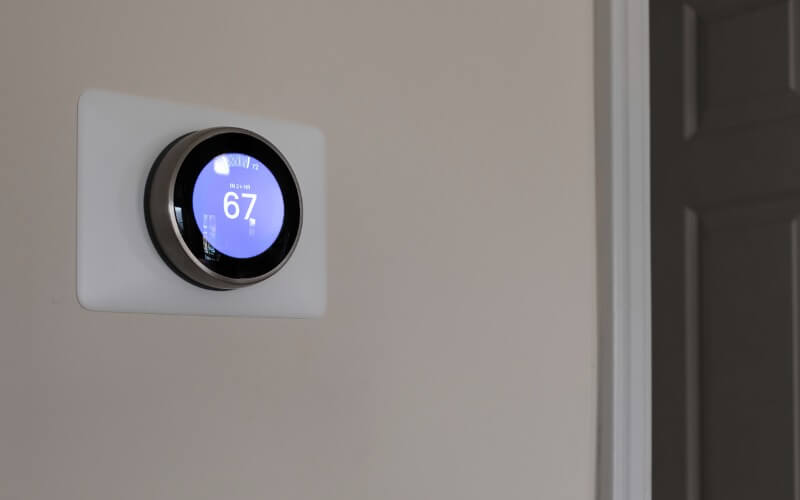As the temperature of the home or specific rooms fluctuates, a digital thermostat instructs the furnace and/or cooling system when to switch on and off. This is a crucial task, since it impacts both comfort and energy costs. This unbiased, expert guide to purchasing thermostats will assist you in locating the ideal thermostat for your home’s heating and cooling system. Because the human body is so sensitive to heat gain and heat loss, it can be difficult to find comfort. In the pursuit of comfort, we equip homes with heating and cooling systems, insulation, energy-efficient windows, weatherstripping, ventilation, and other components designed to prevent heat loss and gain. The digital thermostat, which regulates around 10 percent of all energy used in the United States, is one of the most important instruments for reaching this aim.
The key to comfort, according to studies, is maintaining room temperatures within a 2 degree Fahrenheit range. Within this “comfort window,” humans are oblivious to temperature changes.
Properly performing its function, a thermostat should avoid large fluctuations in room temperature. During the heating season, the room temperature hits a low immediately before the heat is turned on and a high shortly after the heat is turned off.
How does a thermostat operate?
Traditional thermostats operate on the basis of simple scientific principles. The device controls your home’s heating and cooling systems by monitoring the air temperature and activating or disabling the HVAC systems accordingly. A thermostat is very simple and contains fascinating technology.
However, older homes may still have analog thermostats. The majority of traditional thermostats utilize a mercury switch, which consists of a glass vial containing a minute amount of liquid mercury. The mercury conducts electricity and flows like water.
There are three wires included within the glass vial. A wire spans the base of the vial to maintain touch with the mercury. One wire touches the left side of the vial, and when the vial is tilted to the left, mercury contacts both this wire and the one at the bottom. Mercury connects the third and bottom wires when the vial is tilted to the right and the third wire is in touch with the right side of the vial.
The thermostat utilizes these connections to determine when to activate the heating and cooling systems. programmable thermostats began to replace traditional thermostats in the late 1990s.
Should I install a programmed thermostat?
Yes, you probably need a programmable thermostat for the following four reasons:
- Programmable thermostats are cost-effective. The Department of Energy believes that simply adjusting your thermostat by 7 to 10 degrees for eight hours each day, you may save 10 percent annually on your power expenses. With their pre-set scheduling choices, programmable thermostats accomplish this for you. While you and your family are at work, school, or all-day social engagements, you would be basically conserving money. Programmable thermostats also improve the overall efficiency of your HVAC system, hence reducing future maintenance expenses.
- Programmable thermostats are more efficient. Less energy is wasted with increased efficiency. This also implies more earnings for you. Some programmable thermostats can be remotely controlled through smartphones. Therefore, if you’re running late, you may set the thermostat remotely to avoid wasting electricity (and money).
- Programmable thermostats provide time savings. You will not need to adjust the thermostat before you leave the house (which most of us forget anyway). No more early morning or late night back-and-forth. With their pre-set programs, programmable thermostats have your back!
- Programmable thermostats will provide more comfort. Programmable thermostats can make temperature adjustments before you arrive home. There is no lag period between waking up, going to sleep, or returning home to a suitable temperature. Additionally, programmable thermostats have a lower temperature differential than manual thermostats. This implies that your HVAC system will activate sooner to maintain the desired temperature.
INFORMATION REGARDING YOUR THERMOSTAT
If your home’s HVAC system is the center of comfort and efficiency, the thermostat is the brain. For many residents in Lake Forest, Illinois, the thermostat is only a piece of plastic that they periodically touch when they’re too chilly. However, the thermostat’s potential is far more. With these three facts under your belt, you will be able to maximize the comfort and energy efficiency provided by your thermostat.
Energy Savings
Your thermostat can do much more than keep your house warm or cool; it may also help you save money each month. In fact, the U.S. Department of Energy determined that, depending on how you use it, your digital thermostat can help you save up to 10 percent on your power bills. You may create multiple temperature settings for different times of the day with a modern thermostat. During the winter, for instance, you may set your thermostat to an energy-efficient 68 degrees Fahrenheit while you’re at home but lower it while you’re gone.
Energy Accounts
Numerous contemporary thermostats include weekly reports that assess your energy consumption and highlight areas where you may make improvements. Possibly, your report demonstrates a decrease in energy efficiency in the evening, when your family gets home and puts up the heat. This information can be used to modify your habits and reduce your temperature.
Correct Location
Place your thermostat on any interior wall, and you should be set to go, right? Wrong. The position of your thermostat might alter the heating and cooling efficiency of your home. If you place your thermostat close to a window or door, it may cause “ghost readings,” which prevent the thermostat from recognizing the home’s true temperature and may significantly impact the heating and cooling performance of your HVAC system.
Conclusion
Many homeowners can’t wait to test out smart thermostats and see whether this intelligent equipment lives up to its name. Having a digital thermostat provides you with considerable and practical benefits, particularly in terms of your monthly power expenditure. Nevertheless, there is more to consider than just your power cost. Smart thermostats are extraordinarily practical.










